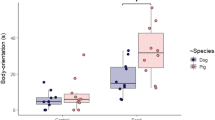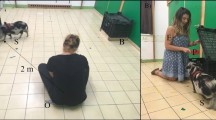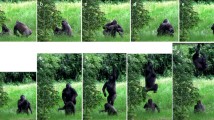Abstract
There is contention concerning the role that domestication plays in the responsiveness of canids to human social cues, with most studies investigating abilities of recognized domestic dog breeds or wolves. Valuable insight regarding the evolution of social communication with humans might be gained by investigating Australian dingoes, which have an early history of domestication, but have been free-ranging in Australia for approximately 3500–5000 years. Seven ‘pure’ dingoes were tested outdoors by a familiar experimenter using the object-choice paradigm to determine whether they could follow nine human communicative gestures previously tested with domestic dogs and captive wolves. Dingoes passed all cues significantly above control, including the “benchmark” momentary distal pointing, with the exception of gaze only, gaze and point, and pointing from the incorrect location. Dingo performance appears to lie somewhere between wolves and dogs, which suggests that domestication may have played a role in their ability to comprehend human gestures.



Similar content being viewed by others
References
Agnetta B, Hare B, Tomasello M (2000) Cues to food location that domestic dogs (Canis familiaris) of different ages do and do not use. Anim Cogn 3:107–112
Boitani L, Ciucci P (1995) Comparative social ecology of feral dogs and wolves. Ethol Ecol Evol 7:49–72
Bräuer J, Kaminski J, Riedel J, Call J, Tomasello M (2006) Making inferences about the location of hidden food: social dog, causal ape. J Comp Psychol 120:38–47
Call J, Bräuer J, Kaminski J, Tomasello M (2003) Domestic dogs (Canis familiaris) are sensitive to the attentional state of humans. J Comp Psychol 117:257–263
Clutton-Brock J (1995) Origins of the early dog: domestication and early history. In: Serpell J (ed) The domestic dog: its evolution, behavior and interactions with people. Cambridge University Press, Cambridge, UK, pp 7–20
Cooper J, Ashton C, Bishop S, West R, Mills D, Young R (2003) Clever hounds: social cognition in the domestic dog (Canis familiaris). Appl Anim Behav Sci 81:229–244
Corbett L (1985) Morphological comparisons of Australian and Thai dingoes: a reappraisal of dingo status, distribution and ancestry. Proc Ecol Soc Aust 13:277–291
Corbett L (1995) The Dingo in Australia and Asia. University of New South Wales Press, Sydney, Australia
Fentress J (1967) Observations on the behavioral development of a hand-reared male timber wolf. Am Zool 7:339–351
Field A (2005) Discovering statistics using SPSS, 2nd edn. SAGE Publications, London
Frank H, Frank M (1982) On the effects of domestication on canine social development and behaviour. Appl Anim Ethol 8:507–525
Gácsi M, Miklósi A, Varga O, Topál J, Csányi V (2004) Are readers of our face readers of our minds? Dogs (Canis familiaris) show situation-dependent recognition of human’s attention. Anim Cogn 7:144–153
Gácsi M, Gyóri B, Miklósi A, Virányi Z, Kubinyi E, Topál J, Csányi V (2005) Species-specific differences and similarities in the behavior of hand-raised dog and wolf pups in social situations with humans. Dev Psychobiol 47:111–122
Gácsi M, Philip J, Miklósi A (2009) Which way does domestication work: creating new traits or modifying timing? J Vet Beh 4:58
Gollan K (1984) The Australian Dingo: in the shadow of man. In: Archer M, Clayton G (eds) Vertebrate zoogeography and evolution in Australasia: animals in space and time. Hesperian Press, Perth, Australia, pp 921–927
Hare B, Tomasello M (1999) Domestic dogs (Canis familiaris) use human and conspecific social cues to locate hidden food. J Comp Psychol 113:173–177
Hare B, Tomasello M (2005) Human-like social skills in dogs? Trends Cogn Sci 9:439–444
Hare B, Call J, Tomasello M (1998) Communication of food location between human and dog (Canis familiaris). Evol Comm 2:137–159
Hare B, Brown M, Williamson C, Tomasello M (2002) The domestication of social cognition in dogs. Science 298:1634–1636
Hare B, Plyusnina I, Ignacio N, Schepina O, Stepika A, Wrangham R, Trut L (2005) Social cognitive evolution in captive foxes is a correlated by-product of experimental domestication. Curr Biol 15:226–230
Jones R (1970) Tasmanian aborigines and dogs. Mankind 7:256–271
Koler-Matznick J, Brisbin I, Feinstein M, Bulmer S (2003) An updated description of the New Guinea singing dog (Canis hallstromi, Troughton 1957). J Zool (Lond) 261:109–118
Kruska D (2005) On the evolutionary significance of encephalization in some eutherian mammals: effects of adaptive radiation, domestication, and feralization. Brain Behav Evol 65:73–108
Lumholtz C (1980) Among cannibals. Australian National University Press, Canberra, Australia
Macintosh N (1975) The origin of the dingo: an enigma. In: Fox M (ed) The wild canids: their systematics, behavioural ecology and evolution. Van Nostrand Reinhold Company, New York, pp 87–106
McKinley J, Sambrook T (2000) Use of human-given cues by domestic dogs (Canis familiaris) and horses (Equus caballus). Anim Cogn 3:13–22
Miklósi A, Soproni K (2006) A comparative analysis of animals’ understanding of the human pointing gesture. Anim Cogn 9:81–93
Miklósi A, Polgárdi R, Topál J, Csányi V (1998) Use of experimenter-given cues in dogs. Anim Cogn 1:113–121
Miklósi Á, Kubinyi E, Topál J, Gácsi M, Virányi Z, Csányi V (2003) A simple reason for a big difference: wolves do not look back at humans, but dogs do. Curr Biol 13:763–766
Miklósi A, Topál J, Csányi V (2004) Comparative social cognition: what can dogs teach us? Anim Behav 67:995–1004
Miklósi A, Pongrácz P, Lakatos G, Topál J, Csányi V (2005) A comparative study of the use of visual communicative signals in interactions between dogs (Canis familiaris) and humans and cats (Felis catus) and humans. J Comp Psychol 119:179–186
Milham P, Thompson P (1976) Relative antiquity of human occupation and extinct fauna at Madura cave, southeastern Western Australia. Mankind 10:175–180
Price EO (1984) Behavioral aspects of animal domestication. Q Rev Biol 59:1–32
Reid PJ (2009) Adapting to the human world: dog’s responsiveness to our social cues. Behav Proc 80:325–333
Riedel J, Buttelmann D, Call J, Tomasello M (2006) Domestic dogs (Canis familiaris) use a physical marker to locate hidden food. Anim Cogn 9:27–35
Riedel J, Schumann K, Kaminski J, Call J, Tomasello M (2008) The early ontogeny of human–dog communication. Anim Behav 75:1003–1014
Rooney N, Bradshaw J, Robinson I (2001) Do dogs respond to play signals given by humans? Anim Behav 61:715–722
Savolainen P, Zhang Y, Luo J, Lundeberg J, Leitner T (2002) Genetic evidence for an east Asian origin of domestic dogs. Science 298:1610–1613
Savolainen P, Leitner T, Wilton A, Matisoo-Smith E, Lundeberg J (2004) A detailed picture of the origin of the Australian dingo, obtained from the study of mitochondrial DNA. Proc Natl Acad Sci USA 101:12387–12390
Schwab C, Huber L (2006) Obey or not obey? Dogs (Canis familiaris) behave differently in response to attentional states of their owners. J Comp Psychol 120:169–175
Smith B, Litchfield C (2009) Review of the relationship between Indigenous Australians, dingoes (Canis dingo), and domestic dogs (Canis familiaris). Anthrozoös 22:111–128
Soproni K, Miklósi A, Topál J, Csányi V (2001) Comprehension of human communicative signs in pet dogs (Canis familiaris). J Comp Psychol 115:122–126
Soproni K, Miklósi A, Topál J, Csányi V (2002) Dogs’ (Canis familiaris) responsiveness to human pointing gestures. J Comp Psychol 116:27–34
Udell M, Dorey N, Wynne C (2008) Wolves outperform dogs in following human social cues. Anim Behav 76:1767–1773
Vas J, Topál J, Gácsi M, Miklósi Á, Csányi V (2005) A friend or an enemy? Dogs’ reaction to an unfamiliar person showing behavioural cues of threat and friendliness at different times. Appl Anim Behav Sci 94:99–115
Vilà C, Savolainen P, Maldonado J, Amorin I, Rice J, Honeycutt R, Crandall K, Lundeberg J, Wayne R (1997) Multiple and ancient origins of the domestic dog. Science 276:1687–1689
Virányi Z, Gácsi M, Kubinyi E, Topál J, Belényi B, Ujfalussy D, Miklósi A (2008) Comprehension of human pointing gestures in young human-reared wolves (Canis lupus) and dogs (Canis familiaris). Anim Cogn 11:373–387
Wilton A (2001) DNA methods of assessing dingo purity. In: Dickman C, Lunney D (eds) A symposium on the dingo. Royal Zoological Society of New South Wales, Mosman, NSW, pp 49–56
Wobber V (2005) The evolution of cooperative signal comprehension in the domestic dog (Canis familiaris). Unpublished Honours Dissertation, Harvard University, Cambridge, MA
Woolpy J, Ginsburg B (1967) Wolf socialization: a study of temperament in a wild social species. Am Zool 7:357–363
Wynne C, Udell M, Lord K (2008) Ontogeny’s impacts on human–dog communication. Anim Behav 76:e1–e4
Zimen E (1987) Ontogeny of approach and flight behavior towards humans in wolves, poodles and wolf- poodle hybrids. In: Frank H (ed) Man and Wolf. Kluwer Academic Publishers, The Netherlands, pp 275–292
Acknowledgments
The authors are indebted to Peter and Lyn Watson at the Dingo Discovery Centre, Victoria, Australia for their generous help and support, as well as volunteers Beth Haywood and Jacki Hutchins for their tireless efforts during data collection. Thanks also to Rob Appleby and three anonymous reviewers for valuable comments on the manuscript. This experiment complies with the current laws of Australia (IMVS Animal Research Committee, project number 121/07).
Author information
Authors and Affiliations
Corresponding author
Rights and permissions
About this article
Cite this article
Smith, B.P., Litchfield, C.A. Dingoes (Canis dingo) can use human social cues to locate hidden food. Anim Cogn 13, 367–376 (2010). https://doi.org/10.1007/s10071-009-0287-z
Received:
Revised:
Accepted:
Published:
Issue Date:
DOI: https://doi.org/10.1007/s10071-009-0287-z




